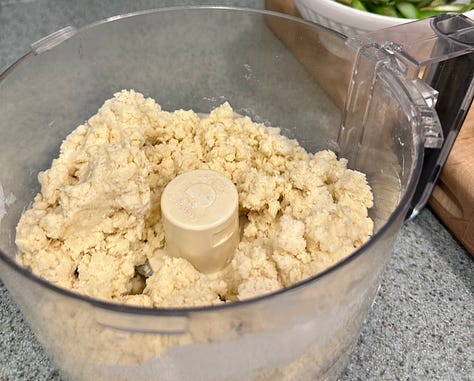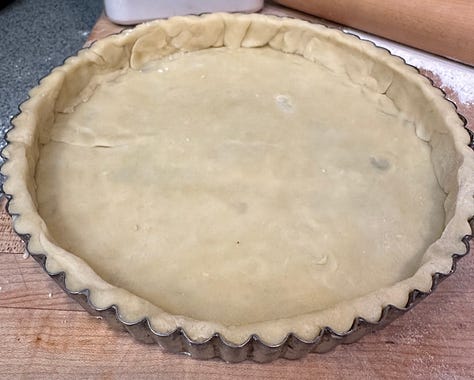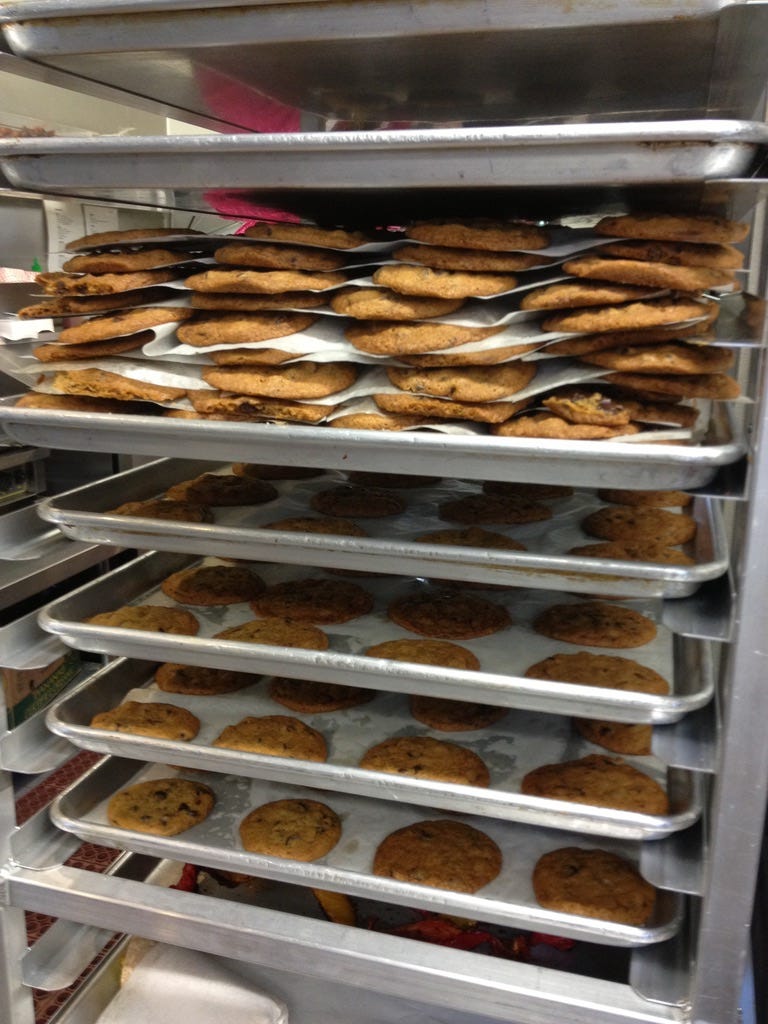The more I read about quiche's history, the more I wanted to include it here—partly for its ancient origins but also for the rivalry, reinvention, and strong opinions and pride it seems to stir.
Quiche has come a long way!
And it has quite the passport. Its earliest roots seem to reach back to Roman times—as a kind of ancient cheesecake—then reappear in medieval Europe around the 1400s in the northeastern region of France, once known as Lothringen. That stretch of land, now known as Lorraine, was alternately under German and French control until the Treaty of Versailles officially returned it to France following World War I. By the 1900s, it had become assimilated into the French repertoire, earning it the stamp of status that the great chef Auguste Escoffier considered worthy of inclusion in his 1903 Guide Culinaire.
In short? This icon has a layered story.
It's esteemed!
There's an actual National Quiche Lorraine Day (May 20th). And there's even a brotherhood—the Confrérie de la Quiche Lorraine—devoted to preserving the authenticity of this classic. They have a Grand Master, a uniform (complete with an apron, a traditional hat, and a medal with a large quiche emblazoned on it). My word!
As National Geographic reports:
"This organization, which exists to showcase and promote the 'true' quiche lorraine, holds a biennial Fête de la Quiche in the town of Dombasle-sur-Meurthe — complete with a baking competition, live music, and a procession. It recently secured funding for road signs to welcome visitors to the official capital of Quiche Lorraine and is currently seeking recognition from UNESCO as part of the region's intangible cultural heritage."
And to further embolden its esteemed status, quiche has a rivaling protector: the APQ (Association for the Protection of the Quiche)! There's even an annual Quiche World Championship, judged by a panel of food journalists, restaurateurs, and bloggers—all holding entries to the standard of "the king of cooks and cook of kings," Auguste Escoffier himself. I want to go there!
In the same article
" According to Escoffier, as long as a version contains eggs, cream, and salt—it's a quiche. Bacon may be the most beloved addition, but alternatives are not only allowed—they're encouraged".
"Only one quiche Lorraine made the podium in 2023, narrowly beating bacon, cheese and mushroom, and spinach and goat's cheese versions to the top spot. That winning Quiche Lorraine, from the Parisian charcuterie house Maison Verot, contained grated Emmental, a Swiss cheese. Truly nothing is sacred — but then, despite the best efforts of the good people of Lorraine in recent years, the shape-shifting quiche has never been a dish to stick to the rules".
I like knowing the history of a dish—especially a classic like quiche, and in particular, Quiche Lorraine. When I decided to step into a professional kitchen, I knew I wanted to learn the foundations of classical French cuisine. And I'm glad I did. That training became the building block of my career. I could make a hollandaise, a velouté, a consommé—not that I'd whip those up today in this modern food moment—but the techniques behind them I use in countless ways.
The components of a great quiche are essential, straightforward, and foundational: a buttery, flaky crust and a rich, perfectly cooked custard. Get those right, and you've got the makings of a thousand beautiful things.
What started this whole conversation about quiche?
A recent stop at Stubborn Girl Farm. I saw Kammy's pre-baked crust sitting there, just waiting for its filling, and I immediately wanted to run home and make one, too. I had forgotten—and then quickly remembered—how much I love quiche. It's such an old-school move. Do you know the glory of it?
Asparagus + Gruyère Quiche
Inspired by Mastering the Art of French Cooking
The first quiche I ever made was Quiche Lorraine—from Julia Child’s Mastering the Art of French Cooking. I still use the same custard base today, changing up the fillings depending on the season—or my mood. The crust is straight from Julia, too.
Serves: 4–6
Oven: Preheat to 375°F (190°C)
Ingredients
3 whole eggs
1 1/2 cups heavy cream
1 tsp salt
1/4 tsp white pepper (or black, if that’s what you’ve got)
Pinch of nutmeg
2 tbsp. minced shallot
1 tbsp. unsalted butter
2 cups fresh asparagus, blanched and sliced into 1/2-inch pieces
1/4 cup grated Gruyère cheese
Optional: 2 tbsp thinly sliced fresh basil or chives
1 pre-baked 9-inch pastry shell (see butter crust recipe)
Instructions
Make the custard:
In a medium bowl, beat the eggs with the cream, salt, pepper, and nutmeg.Cook the shallots:
In a small pan, melt the butter over low heat. Add the minced shallots and cook until soft, about 10 minutes. Let cool slightly.Assemble the quiche:
Mix the asparagus with sautéed shallots, and optional herbs and lay into the pre-baked crust. Pour the custard over the top, then sprinkle with Gruyère.Bake:
Place on a baking sheet and bake for 25–30 minutes, or until the filling is just set and lightly golden on top.I once heard Martha Stewart say that every cook needs a great crust recipe—and the skill to make it. I agree! This is that recipe. Buttery, flaky, reliable. A Foundation you can build on. I think the winning combination for flavor and flakiness is butter and a bit of vegetable shortening. Mastering the technique of this is possible, I promise! Keep the butter cold, handle the dough delicately, use ice cold water and you will have success. I usually double this recipe and keep half in the freezer.
Pâte Brisée (Basic French Pastry Crust)
Adapted from Mastering the Art of French Cooking
Makes one 9-inch tart or quiche crust
Ingredients
1 cup all-purpose flour
1/2 tsp salt
3 ounces (3/4 stick) cold unsalted butter, cut into small cubes
2 tablespoons cold shortening
3 tablespoons ice water
Instructions
Mix the dry:
In the bowl of a food processor, combine the flour and salt.Cut in the butter:
Add the cold butter cubes. Pulse one or two times to break up the butter. Add the cold shortening and pulse until the mixture looks like coarse crumbs with some pea-sized bits.Add water:
Sprinkle in the ice water and pulse 2 or 3 times or until the dough just starts to come together. Add a drop or two more water if needed until it holds together without being wet or sticky.Form and chill:
Gather the dough into a ball, flatten into a disk, wrap in plastic or parchment, and refrigerate for at least 30 minutes (or up to 2 days).Roll it out:
On a lightly floured surface, roll the dough into a 12-inch circle. Carefully transfer it to a 9-inch tart or pie pan. Press it in gently and trim or fold the edges in on themselves to make an even edge.Blind bake:
Preheat oven to 375°F (190°C). Prick the bottom of the crust with a fork. Line with parchment or aluminum foil and fill with pie weights or dried beans. Bake for about 15 minutes, until the crust has firmed up, then remove the weights and bake another 5–7 minutes until lightly golden.


from left to right, finished dough, rolled and ready to lay into pan, ready for baking
It’s Cookie of the Month time again—
and here comes another classic, one that’s completely and unapologetically American.
Guess what it is?
Stay tuned… (or take a peek below and see if you’re right).







Oh that's great-so did I!
I learned something new about quiches!!! Thank you for sharing these fun stories.